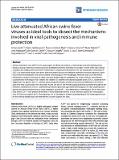Por favor, use este identificador para citar o enlazar a este item:
http://hdl.handle.net/10261/125942COMPARTIR / EXPORTAR:
 SHARE SHARE
 CORE
BASE CORE
BASE
|
|
| Visualizar otros formatos: MARC | Dublin Core | RDF | ORE | MODS | METS | DIDL | DATACITE | |

| Título: | Live attenuated African swine fever viruses as ideal tools to dissect the mechanisms involved in viral pathogenesis and immune protection |
Autor: | Lacasta, Anna; Monteagudo, P. L.; Jiménez-Marín, Ángeles; Accensi, Francesc; Ballester, M.; Argilaguet, J. M.; Galindo-Cardiel, I.; Segalés, J.; Salas Falgueras, María Luisa CSIC ; Domínguez, J.; Moreno, Ángela CSIC ORCID; Garrido Pavón, Juan José CSIC ORCID; Rodríguez, Fernando | Fecha de publicación: | 20-nov-2015 | Editor: | BioMed Central | Citación: | Veterinary Research 46(1):135 (2015) | Resumen: | African swine fever virus (ASFV) is the causal agent of African swine fever, a hemorrhagic and often lethal porcine disease causing enormous economical losses in affected countries. Endemic for decades in most of the sub-Saharan countries and Sardinia, the risk of ASFV-endemicity in Europe has increased since its last introduction into Europe in 2007. Live attenuated viruses have been demonstrated to induce very efficient protective immune responses, albeit most of the time protection was circumscribed to homologous ASFV challenges. However, their use in the field is still far from a reality, mainly due to safety concerns. In this study we compared the course of the in vivo infection caused by two homologous ASFV strains: the virulent E75 and the cell cultured adapted strain E75CV1, obtained from adapting E75 to grow in the CV1 cell-line. Interestingly, the kinetics of both viruses not only differed on the clinical signs that they caused and in the virus loads found, but also in the immunological pathways activated throughout the infections. Furthermore, E75CV1 confirmed its protective potential against the homologous E75 virus challenge and allowed the demonstration of poor cross-protection against BA71, thus defining it as heterologous. The in vitro specificity of the CD8+ T-cells present at the time of lethal challenge showed a clear activation against the homologous virus (E75) but not against BA71. These findings will be of utility for a better understanding of ASFV pathogenesis and for the rational designing of safe and efficient vaccines against this virus. | Descripción: | Lacasta, Anna et al. | Versión del editor: | http://dx.doi.org/10.1186/s13567-015-0275-z | URI: | http://hdl.handle.net/10261/125942 | DOI: | 10.1186/s13567-015-0275-z | ISSN: | 0928-4249 | E-ISSN: | 1297-9716 |
| Aparece en las colecciones: | (IAS) Artículos (CBM) Artículos (INIA) Artículos |
Ficheros en este ítem:
| Fichero | Descripción | Tamaño | Formato | |
|---|---|---|---|---|
| 13567_2015_Article_275.pdf | 2 MB | Adobe PDF |  Visualizar/Abrir |
CORE Recommender
PubMed Central
Citations
48
checked on 01-abr-2024
SCOPUSTM
Citations
65
checked on 21-abr-2024
WEB OF SCIENCETM
Citations
66
checked on 27-feb-2024
Page view(s)
288
checked on 24-abr-2024
Download(s)
378
checked on 24-abr-2024

